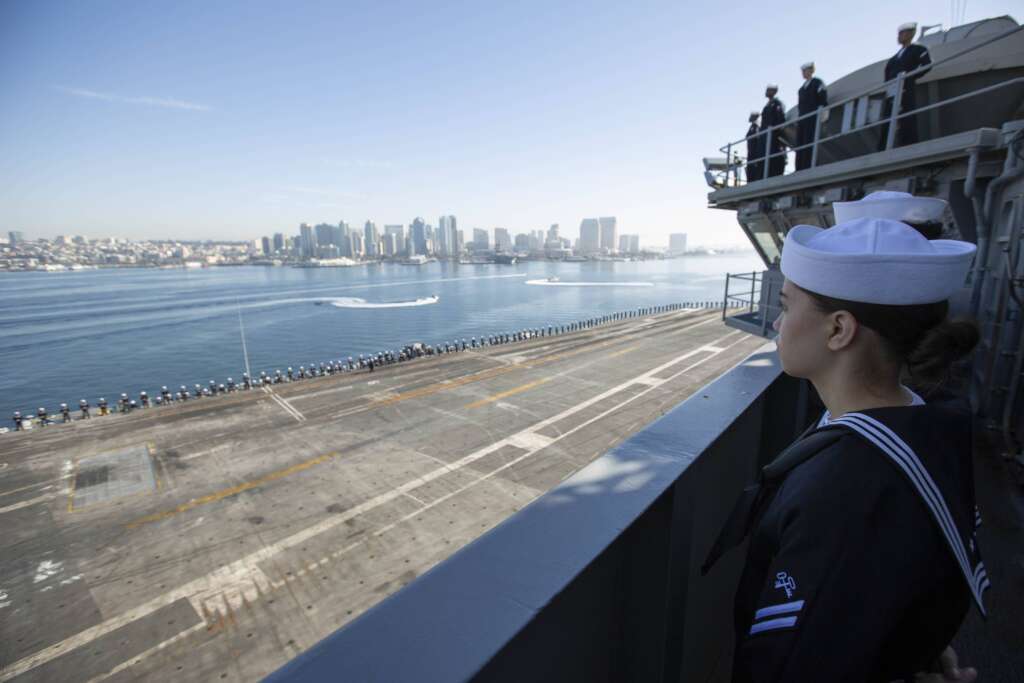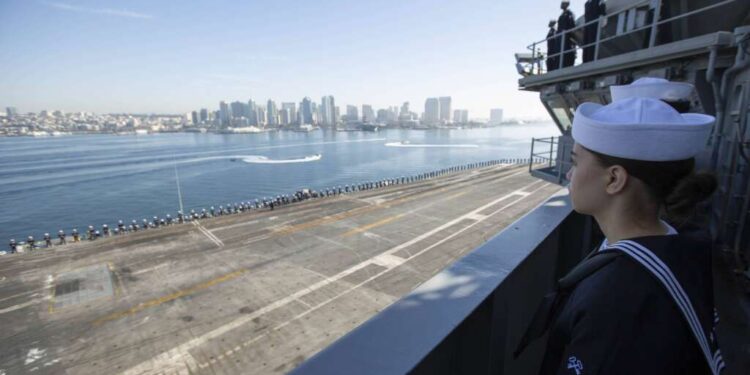
The U.S.S. Abraham Lincoln returned to its homeport in San Diego on Friday after a multi-month tour at sea — including an unusually long stint of 107 days without a port call. But the Nimitz-class aircraft carrier had something that’s been unheard-of until now: high-speed internet connectivity, even when it was thousands of miles from shore.
The connectivity sailors had available during the Lincoln’s sea tour was the biggest demonstration to date of a Navy project called Sailor Edge Afloat and Ashore, which aims to bring shore-grade communications to underway ships, and the related Flank Speed Edge, the Navy initiative to extend its cloud computing offerings to places where bandwidth is a major challenge.
Using proliferated low-earth orbit satellites and 5G cellular networks, the Lincoln was able to transmit and receive volumes of data that previously would have been unthinkable in an afloat environment: about eight terabytes per day.
But the project first started more than two years ago, when officials first realized the technology was now available to connect ships to networks for purposes other than mission-critical tactical and business applications.
“In August of 2022, we went full-in on trying to figure out that solution. We also wanted to provide connectivity in a meaningful way for sailors, because we’re all connected in the world,” Capt. Kevin White, the Lincoln’s combat systems officer, told Federal News Network in an at-sea interview this month, shortly before the ship’s return home. “When you disrupt connections by going to sea, you disrupt one’s own identity and how they conduct their life. We believe that as you enable connections, it’s a way to enable retention in the United States Navy. It’s also a way for people to feel a more meaningful connection to their job.”
‘Layered’ approach to personal, mission-related connectivity
During the five-month deployment — covering some 78,000 miles — the crew used those new connections for everything from YouTube and Instagram to Navy business applications to the warfighting systems that the military’s older, much slower satellite communications links were first set up to serve decades ago.
And while the new Sailor Edge connections offer orders of magnitude more bandwidth than those traditional military SATCOM links, planners also had to keep in mind that they were going to be serving a crew of 6,000 people aboard the Lincoln, so some amount of rationing needed to be taken into consideration.
Still, as long as the ship was operating in areas where network connectivity wasn’t an issue for operational security, in general, there turned out to be plenty of bandwidth to go around, White said.
“What we did was we took a layered concept. One thing we expect is for sailors to be able to text message or call home anytime, so we built a series of layers in how we bucket the traffic and then how it is prioritized amongst available bandwidth,” he said. “We prioritize our business applications — we have quality of work traffic shaping layers, and those are our highest priority. But it also turns out that those are really kind of low traffic sources. And then we have many quality of life traffic shaping layers … at any given time, the layers are provisioning bandwidth across those services.”
Each sailor on board was given an account to log into the ship’s WiFi network, similar to the portals one might use at a hotel.
“And as they do, that tracks how much data they use, and then we have some mechanisms that enforce where they are allowed to go versus where they are not allowed to go per DoD policy,” White said. “We actually layer up content based on the value that content provides somebody combined with how bandwidth-heavy it is. I expect everybody to be able to make a phone call and send a text message, and then some level of personal entertainment value. However, it is definitely not unlimited.”
Testing the waters with more providers
During long transits far from shore (the Lincoln’s tour spanned from the Western Pacific to an unexpected deployment to the Middle East), the high-speed links were supplied mainly by Starshield, SpaceX’s P-LEO offering for government customers. But White said several other satellite providers have expressed interest in the Sailor Edge effort.
“We’ve had some awesome opportunities to exercise some of those game-changing capabilities,” he said. “It’s kind of like if you build it, they will come, and we’ve now seen a full force effort of folks interested to scale out both our capability on ships, as well as in various shore sites around the world. So that’s fantastic, and that was exactly what we envisioned from the start.”
But closer to land, the Lincoln’s latest deployment also demonstrated the ability to connect the ship to commercial 5G towers at what turned out to be surprisingly long distances.
“We tested a multi-5G cellular aggregation capability with cellular antennas, and the intent of the test was if a ship is in a foreign port, what value does (5G) that provide that ship from a cost and a scalability perspective? But we also wanted to see if we could actually get some measurable traffic to pass while we’re actually at sea,” White said. “And it worked. It worked phenomenally. I was quite surprised at how far away we were able to pass traffic at sea — in excess of 100 miles. And it just shows the scalability of one the Sailor Edge Afloat and Ashore capability, as well as how we can integrate with other options and continue to move the needle.”
Copyright
© 2024 Federal News Network. All rights reserved. This website is not intended for users located within the European Economic Area.






